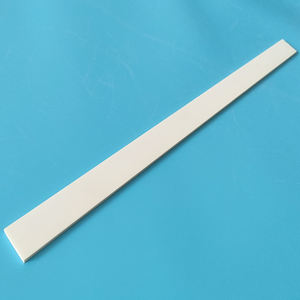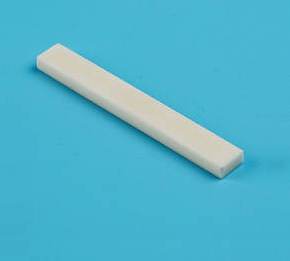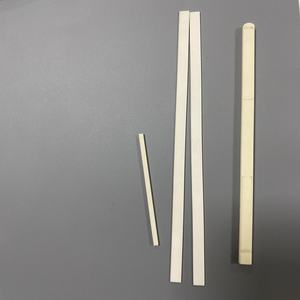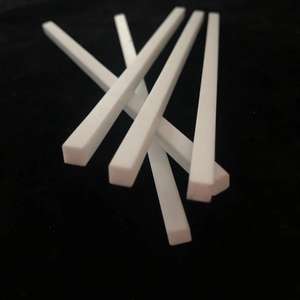Professional industry ceramic supplier, silicon nitride, silicon carbide, aluminum nitride and any other kinds of ceramics.
PRODUCT PARAMETERS
Description
Overview of Laser Scribed 0.25mm 0.30mm Thick Aluminum Oxide Substrate Alumina Ceramic Al2O3 Plate
Laser Scribed 0.25mm 0.30mm Thick Aluminum Oxide Substrate Alumina Ceramic Al2O3 Plate are one of the most widely used and versatile technical ceramics, prized for their excellent combination of properties. Composed primarily of aluminum oxide (Al₂O₃), they offer outstanding hardness, wear resistance, and electrical insulation, even at high temperatures. From low-purity grades for general industrial use to high-purity compositions for demanding applications, alumina ceramics provide a cost-effective and reliable solution across a vast range of industries.
Features of Laser Scribed 0.25mm 0.30mm Thick Aluminum Oxide Substrate Alumina Ceramic Al2O3 Plate
-
High Hardness & Wear Resistance: Excellent resistance to abrasive wear, making it ideal for liners, nozzles, and guides.
-
Superior Electrical Insulation: Maintains high electrical resistivity and dielectric strength, even at elevated temperatures.
-
Excellent Thermal Stability: Withstands high operating temperatures and exhibits good thermal conductivity.
-
High Mechanical Strength: Possesses good compressive strength and stiffness.
-
Chemical Inertness: Resists corrosion from a wide range of acids, alkalis, and other harsh chemicals.
-
Cost-Effectiveness: A highly versatile and economically efficient ceramic material for numerous applications.
Specification of Laser Scribed 0.25mm 0.30mm Thick Aluminum Oxide Substrate Alumina Ceramic Al2O3 Plate
This product is a slim alumina ceramic plate. It uses aluminum oxide material. Al2O3 is the chemical name. The plate thickness can be found in two sizes. You can get 0.25 mm thick plates. You can additionally obtain 0.30 mm thick plates. Both alternatives are available. This ceramic material is very solid. It is difficult and sturdy. It manages high warmth well. Good electric insulation is one more advantage. The surface area is smooth and flat. This monotony is necessary for many uses. Laser scribing is an essential feature. An unique laser marks lines on the plate. These scribe lines are extremely thin and specific. They allow for tidy breaks later. You can snap home plate along these lines quickly. This provides tidy, straight edges. It minimizes breaking or fracturing. This makes home plate very easy to collaborate with. You can cut it to specific dimensions required. The laser procedure is exact and rapid. It makes sure consistent results every single time. This alumina substratum is stable. It does not change size much with temperature. This dimensional security is crucial. It maintains parts the appropriate form during usage. The product resists wear and rust. Chemicals do not conveniently harm it. It lasts a long time even in challenging conditions. These plates are utilized in electronic devices often. They are good for circuit card or sensors. LED lights systems may use them. Commercial devices finds them beneficial too. Slim porcelains such as this are needed for contemporary tools. They use a reliable base product. The mix of slimness and scribing is practical. It saves time throughout setting up. You obtain a strong, protecting plate all set for exact cutting.
Applications of Laser Scribed 0.25mm 0.30mm Thick Aluminum Oxide Substrate Alumina Ceramic Al2O3 Plate
Laser scribed alumina ceramic plates supply distinct benefits. These plates are really slim, just 0.25 mm or 0.30 mm thick. This slimness is essential for numerous uses. Alumina, or Al2O3, is a strong ceramic product. It handles heats well. It also conducts warmth effectively. Electrical insulation is an additional major advantage. These residential properties make slim alumina plates really helpful.
One main application remains in electronics. The thin plate functions as a shielding layer. It separates electric components in limited rooms. This is vital for miniaturized devices. The laser scribed lines are important as well. They produce precise patterns externally. These patterns assist the positioning of tiny electronic components. They can also create micro-channels. These channels take care of fluids in lab-on-a-chip tools. The slimness allows complicated designs in little areas.
Warm administration is one more big usage. The plate spreads out warm far from delicate components. This safeguards electronic elements from overheating. It functions well for LED lights systems. It aids sensors operate dependably also. The laser scribing can mark particular areas. This help assembly procedures. It aids setting components accurately.
Home plates are additionally challenging. They resist wear and scratching. This sturdiness is useful in mechanical applications. It is necessary where little components scrub with each other. The thin profile matches portable devices. The scribed lines can provide referral points. They aid align components during assembly.
Chemical resistance is another strength. Alumina ceramic does not react with several chemicals. This makes it risk-free for harsh environments. It works well for sensing unit real estates. It shields fragile picking up elements. It’s good for lab tools elements also. The slim plate offers protection without mass.
Laser scribing supplies exact personalization. It allows for details layouts on the ceramic surface area. This tailoring fits particular application needs. The combination of slimness, material buildings, and scribing is effective. It solves problems in electronic devices, thermal systems, and mechanical gadgets.
Company Profile
Tanki New Materials Co.Ltd. focus on the research and development, production and sales of ceramic products, serving the electronics, ceramics, chemical and other industries. Since its establishment in 2015, the company has been committed to providing customers with the best products and services, and has become a leader in the industry through continuous technological innovation and strict quality management.
Our products includes but not limited to Aerogel, Aluminum Nitride, Aluminum Oxide, Boron Carbide, Boron Nitride, Ceramic Crucible, Ceramic Fiber, Quartz Product, Refractory Material, Silicon Carbide, Silicon Nitride, ect. please feel free to contact us.

Payment Methods
T/T, Western Union, Paypal, Credit Card etc.
Shipment Methods
By air, by sea, by express, as customers request.
5 FAQs of Laser Scribed 0.25mm 0.30mm Thick Aluminum Oxide Substrate Alumina Ceramic Al2O3 Plate
Here are answers to common questions about our laser scribed 0.25mm and 0.30mm thick aluminum oxide (Al₂O₃) alumina ceramic plates.
How do the 0.25mm and 0.30mm thicknesses differ?
The main difference is physical strength. The 0.30mm plate is slightly thicker. This makes it a bit stronger. It handles more stress without breaking. The 0.25mm plate is thinner. It is more flexible. Both offer excellent electrical insulation. Your application decides which thickness fits best.
Why laser scribe these plates?
Laser scribing creates precise lines on the ceramic surface. These lines are weak points. This allows clean breaks along the scribed lines. You get smaller, exact shapes you need. It’s faster than other cutting methods. It also produces less waste material.
Why use aluminum oxide (Al₂O₃) ceramic?
Alumina ceramic has great properties. It withstands very high temperatures. It resists chemical corrosion well. It’s an excellent electrical insulator. It’s also quite hard and durable. These traits make it perfect for demanding electronics and industrial uses.
Are these thin plates fragile?
Yes, they can be fragile because they are very thin. Handle them carefully. Avoid bending them too much. Support them properly during use. The laser scribing helps. It controls where breaks happen. This reduces the chance of random cracking.
What are typical uses for these plates?
These thin, scribed alumina plates are common in electronics. They serve as substrates. Thin-film circuits are built on them. They are used in sensors. They work well in heaters. They are found in various semiconductor applications. Their thinness and precision are key advantages.
REQUEST A QUOTE
RELATED PRODUCTS

92% 95% Alumina Ceramic Lining Plate Aluminum Oxide Ceramic Wear Liner Tile for Coal Washing Industry

Ceramic Fiber Disc, Zirconia Fiber Disc, Aluminum Oxide Fiber Disc, Alo & Zir Polishing 115mm, 125mm

Laser Cutting Alumina Substrate Aluminum Oxide Al2O3 Ceramic PCB Sheet

Alumina Ceramic Parts Aluminum Oxide Chemical Stability Round Hole Straight Cylinder Ceramic Shaft

Wear Resisting Alumina Ceramic Parts Aluminum Oxide Ceramic Shaft for High Speed Pump



